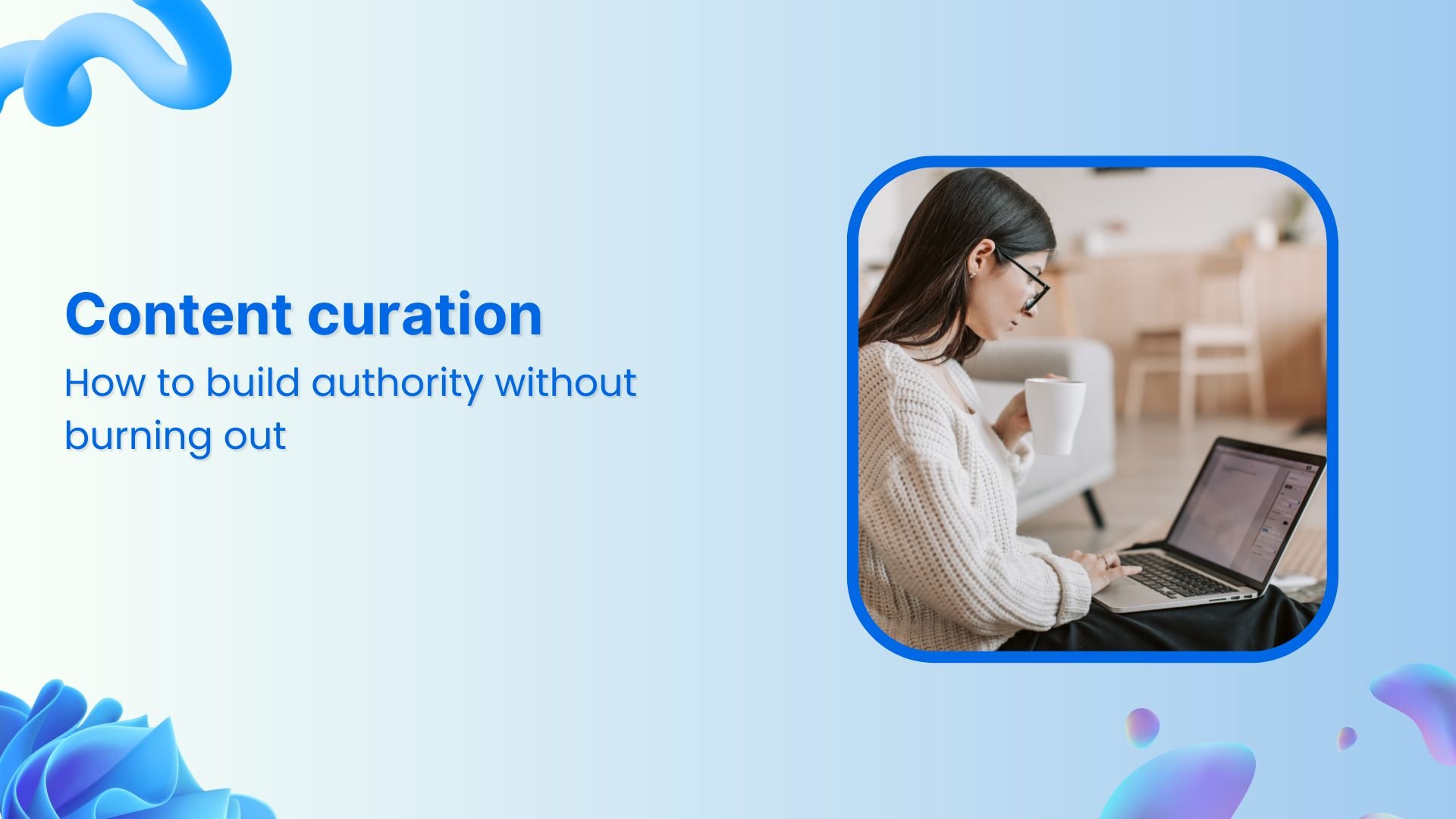Bulk-generate & schedule posts in seconds with Smart Scheduling. Try now!
Content scaling made easy: Strategies and case studies
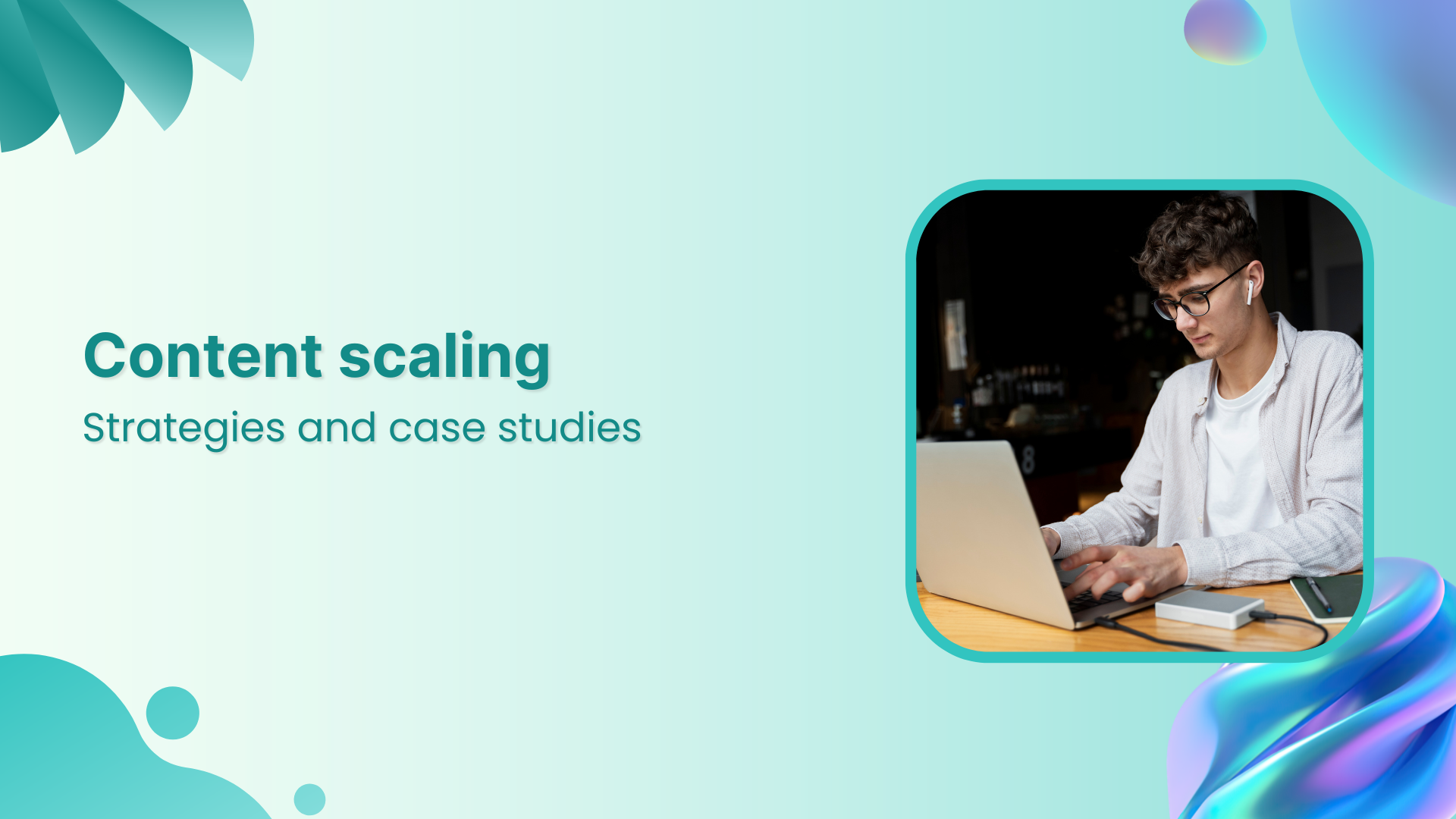
Content creation has never been this easy, thanks to AI-powered tools that help creators, brands, and agencies in content scaling, managing, and analyzing effectively.
Most people think putting out a ton of content across different avenues is the key to getting traction, but it doesn’t work this way. Many create content in bulk at the expense of quality, which is a no-go.
Those who build systems for creating, scheduling, managing, and analyzing marketing content across different platforms stay ahead.
So, content scaling is one of the content marketing strategies that savvy marketers can’t afford to lose.
Let’s explore what it is and how anyone can cash in.
Experience organized workflow with a unified social media management platform for agencies.
Try ContentStudio for FREE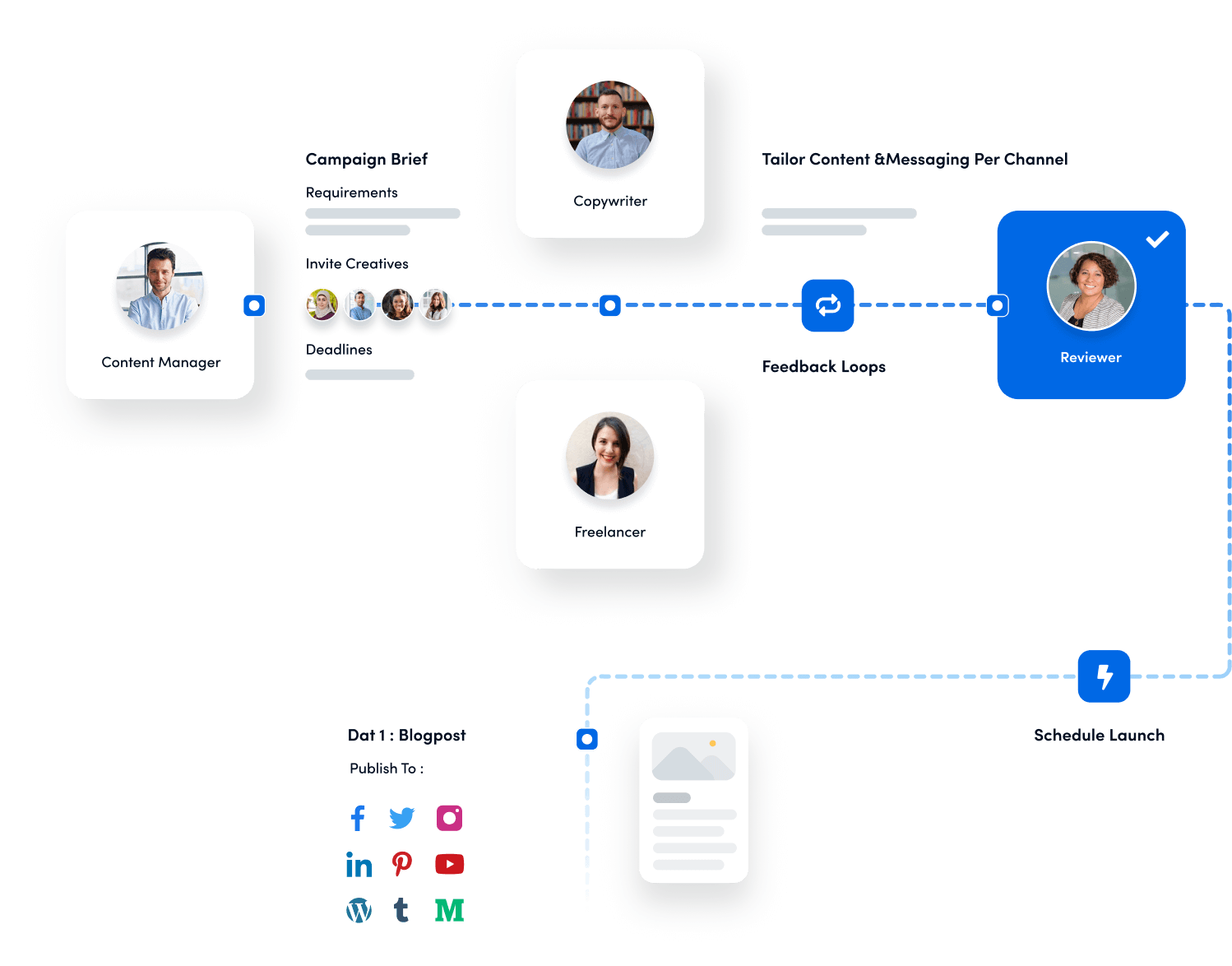
What is content scaling?
Content scaling is a content strategy that allows marketers, brands, and agencies to create, manage, and publish more high-quality content effectively through systematic processes.
The fundamental structure of establishing a powerful content scaling plan stands on streamlining systems, leveraging AI tools, and training the teams to put out content at scale without compromising the quality of the content.
Organizations, agencies, brands, and influencers always eye wider audiences, enhanced social media reach, and increased engagement across multiple platforms. So, content scaling helps achieve all those targets.
Content scaling vs. content marketing
Content scaling and content marketing are two slightly different approaches in digital marketing, so they can’t be used interchangeably. However, some budding marketers might not distinguish between these concepts.
Content scaling is the art of creating, managing, and publishing more, high-quality content without affecting the quality of content. Whereas, content marketing is a broader digital marketing strategy that emphasizes on capitalizing different types of content (such as articles, videos, podcasts, and infographics) to find and engage the target audience.
Evolution of content scaling
Content scaling has evolved significantly over the years, driven by advancements in technology, changes in consumer behavior, and shifts in digital marketing strategies. Initially, content creation was manual and time-consuming, often limited to blogs, magazines, or TV programs.
As the internet matured, businesses produced more content to attract, engage, and convert the audience. It led marketers to rank on search engines, giving rise to SEO-driven content at scale.
The emergence of content management systems (CMS), social media platforms, and automation tools made creating and distributing large volumes of content easier. Today, AI-powered tools and generative models like ChatGPT, DeepSeek, and Gemini have revolutionized content scaling by enabling faster, more efficient, and personalized content production.
The focus has shifted from quantity to quality at scale, ensuring that even high-volume content is meaningful, engaging, and tailored to audience needs.
Why content scaling is important for business growth
Unsurprisingly, every social media platform is being bombarded with content, and search engines struggle to sift through the noise and get to the best of the collection.
While most businesses and marketers make the mistake of posting content occasionally, there is still cut-throat competition across several niches.
Content scaling is important for a business’s growth primarily to ensure that it stays relevant in the chaotic, cheesy marketing world where everyone wants to sell you something.
A huge factor in the fierce competition in the digital marketing space is the advent of AI tools, which make it easier for everyone to produce as much content as they want to gain a competitive advantage over others.
Therefore, the situation demands a crystal clear, unapologetic approach to content scaling that follows the roadmap to business growth.
Content scaling vs. content creation: key differences
Here are the major differences between content scaling and content creation:
1. Primary focus
Content creation primarily focuses on producing new, original content from scratch, whether it’s articles, videos, graphics, or podcasts. It involves discovering new ideas and transforming them into tangible content.
Content Discovery
Find the top-performing content on the web and never run out of social media post ideas.
Get Started for FREE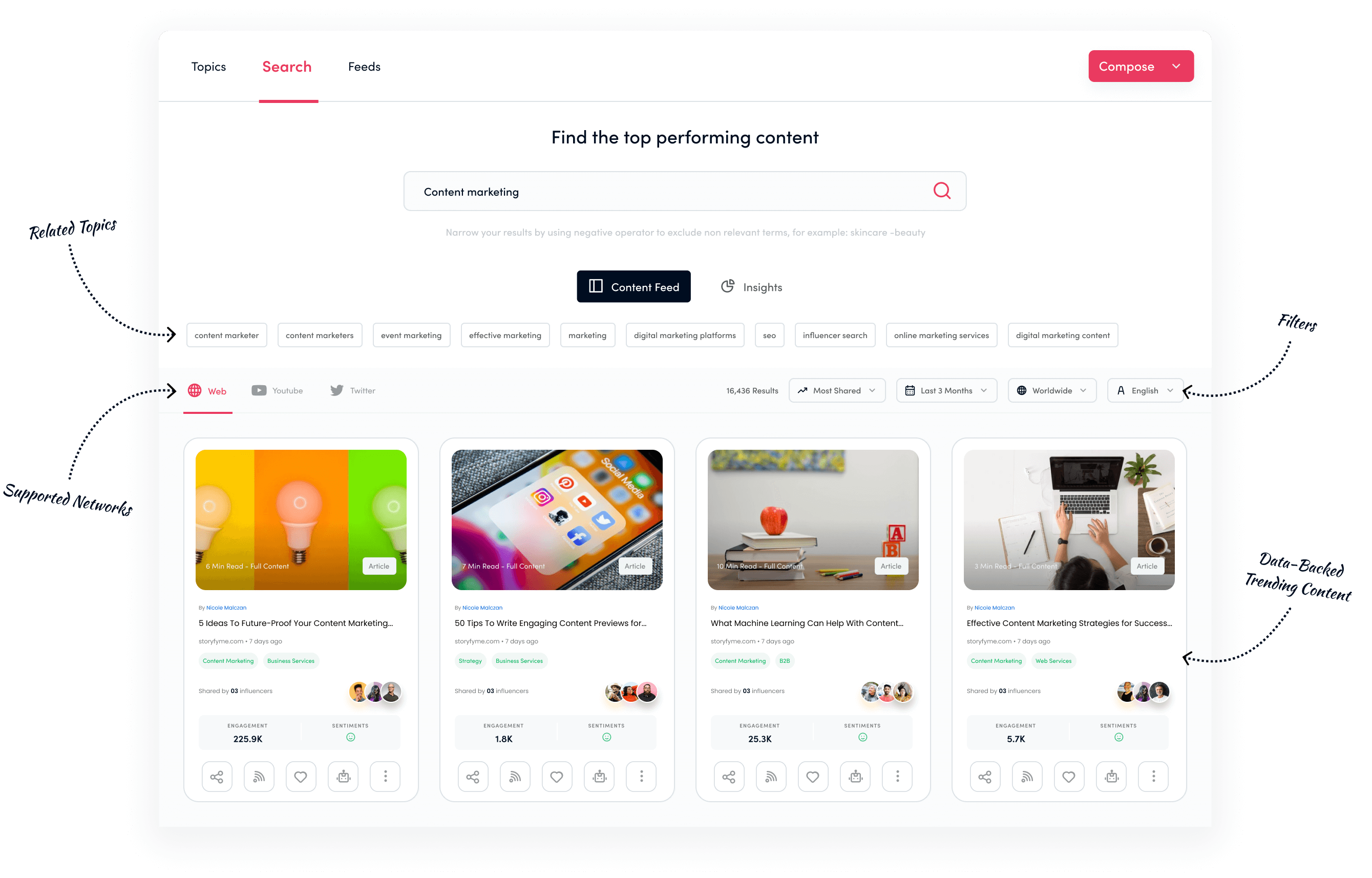
On the other hand, content scaling emphasizes optimizing processes, repurposing content, and increasing content output to reach a wider audience without spending extra resources.
2. Campaign objective
Content creation aims to deliver value through creativity, storytelling, or infotainment that helps creators or brands connect with the target audience. Furthermore, the campaign objective of content creation includes building brand reputation, developing thought leadership, and audience engagement.
In contrast, content scaling targets growing the brand footprint rapidly to achieve marketing goals like increasing website traffic, boosting SEO rankings, or multiplying brand visibility across platforms.
3. Process distinction
Content creation is a creative process that involves ideation, research, writing, editing, designing, shooting, and sometimes collaborating with different specialists. Every piece demands individualized attention and a unique creative flow.
Content scaling, however, introduces concepts such as automation, templates, team delegation, and collaborations to produce multiple pieces at once. Both processes have distinctions that translate into the whole process.
3. Speed and volume
Content creation tends to be slower as influencers, marketers, or creators spend considerable time on ideation, research, and crafting content that resonates with their audience.
In contrast, content scaling is all about accelerating the content output, enabling the team to produce content in bulk quantity within a short period using templates or AI-powered tools.
4. Success metrics
Success in content creation is often judged based on audience engagement, emotional feedback, and social impact. The creator usually follows a qualitative approach to ensure the content connects with the target audience.
Whereas, in content scaling, the success is measured through numbers, such as shares, likes, comments, traffic volume, impressions, backlinks, number of posts published, and other quantitative performance metrics.
5. Risk factors
Risk factors in content creation include burnout, creative blocks, and inconsistent content publishing. Since the majority of tasks are manual, they can become tiresome at some point.
Content scaling isn’t risk-free either. Brands and creators can fall into the trap of quality dilution, brand voice inconsistency, and impostor syndrome, which leads to self-doubt and a lack of confidence.
So, these are some of the major differences between content creation and scaling.
Content scaling strategies for different business sizes
1. Individual/Creator
Let’s discuss the content scaling strategies for individuals, creators, and freelancers who don’t have a team and they’re more like a one-man army:
- Focus on repurposing content
Turn one piece of content, such as a blog post into multiple formats like a YouTube video, social media (tex) post, infographics, podcast, and newsletter. Repurposing saves time and maximizes the value of every idea.
- Batch-create and schedule
Choose specific days for batch-creating a particular type of content, such as blog posts, videos, or social media posts. Creating content in bulk allows individuals or creators to schedule content in advance. It helps maintain a consistent publishing routine without constant last-minute work.
P.S. Try ContentStudio for social media content scheduling; it offers a 14-day free trial.
- Use AI tools and templates
Individuals, freelancers, and creators are usually a one-man show. Leverage AI writing assistants, social media templates, and graphics design elements to accelerate content production without compromising creativity. These tools and templates can help individuals create high-quality content faster than ever.
- Outsource repetitive tasks
Outsourcing is a fantastic solution for busy freelancers and creators juggling multiple clients or projects simultaneously. Hiring freelancers for video editing, graphic design, transcription, copywriting, or formatting can help speed up the process. Outsourcing allows you to focus on higher-level creative and strategic work.
2. Small business
Small businesses are an essential segment of the economy. Let’s point out some of the content scaling strategies for small businesses:
- Build a content calendar for content management
Small businesses don’t have the luxury of massive teams. Therefore, they have to delegate tasks among team members. Try a project management tool like Trello, Asana, or ClickUp to map out topics, assign tasks to team members, and set deadlines. You can also try using ContentStudio’s content calendar. Clear workflows prevent bottlenecks and help teams produce more content efficiently.
- Create a powerful blog and SEO content strategy
Design an impactful content strategy based on various content, such as ultimate guides, infographics, webinars, or in-depth videos. Identify the industry-related terms, burning questions, and relevant topics to address in your articles and videos.
Also Read: Top AI tools and strategies for SEO in 2025
- Implement basic automation tools
Marketing automation can be useful when running a content scaling campaign. Use social media schedulers like ContentStudio and email marketing platforms like Mailchimp or ConvertKit to automate social posting, emailing, and tracking. Marketing automation ensures consistency even with a small team.
- Collaborate with freelancers and agencies
Partner with freelance writers, video editors, or small marketing agencies to handle overflow work. Outsourcing tedious tasks often helps businesses focus on their product or service. Moreover, this gives businesses the flexibility to scale up content production without long-term hiring commitments.
3. Large-scale organization
Content scaling for large-scale companies is as important as for small businesses and individuals. Let’s shed some light on the content scaling strategies for large companies:
- Establish a content governance framework
Brands and organizations usually have social media and digital marketing teams that create and follow content protocols. They set clear brand guidelines, editorial standards, and approval workflows across all teams. Governance ensures content quality, consistency, and compliance at a large scale.
- Create specialized content teams
Setting up dedicated teams for blog content, website SEO, social media marketing, and video production is the way to go. Specialization allows teams to focus deeply on specific platforms and formats, eliminating the chance of content errors and missed opportunities.
- Use enterprise-level content platforms.
Enterprise-level content and marketing solutions become inevitable when you’re running content marketing campaigns at the highest level. Invest in advanced CMS systems like Contentful, HubSpot, or Adobe for Business. These tools support high-volume publishing, team collaboration, and omnichannel content marketing management.
- Leverage data-driven content decisions
It’s best to utilize advanced analytics tools to identify top-performing content, audience preferences, and market trends. Let the data guide scaling efforts to ensure that resources are invested where they have the most impact. Usermaven is an excellent website and product analytics tool for brands, organizations, and marketers.

- Expand reach through collaborations
Influencer marketing is considered an underpriced marketing strategy. No wonder companies like SkillShare, Shopify, Hostinger, BetterHelp, Epidemic Sounds, and hundreds of other companies regularly work with YouTube influencers across the globe. Launch influencer campaigns, partner with other brands, and encourage user-generated content. External collaborations allow organizations to scale their content distribution exponentially without creating everything in-house.
Key challenges in content scaling
It’s important to look at the other side of things because everything that shines isn’t gold. Take a look at the key challenges you might face in content scaling:
1. Maintaining content quality
Content quality is an integral element of the content. As the volume of content increases, maintaining the same standard of effectiveness, usefulness, and creativity becomes difficult. There’s always a risk of producing lower-quality material that weakens the brand’s authority.
2. Managing consistency across all platforms
Scaling often means publishing across multiple platforms, such as official blogs, YouTube, Instagram, LinkedIn, and Facebook. Ensuring the brand voice, style, and messaging stay consistent everywhere is a major challenge, especially when different content is being published across all platforms.
3. Avoiding content duplication
When repurposing and producing content at scale, it’s easy to unintentionally create repetitive or redundant content that doesn’t excite the audience as much as other content. This can hurt SEO performance and social media engagement.
4. Handling resource limitations
Content scaling demands more content output, which means hiring freelance social media managers, content writers, graphics designers, video editors, or other team members on the same budget. Small teams or businesses often struggle to balance expanding output and managing available resources wisely.
5. Tracking performance effectively
With dozens or hundreds of pieces being published on multiple platforms, measuring what’s working becomes complex. Relying on surface-level metrics can mislead scaling efforts and waste resources. Brands and influencers opt for the best social media analytics tools to track social content performance.

6. Protecting brand identity
Putting out blog and social content at scale can sometimes dilute the brand’s unique identity, especially when content creation is outsourced or heavily automated. Ensuring every piece still reflects the brand’s core values is critical to the brand’s reputation.
So, these are some of the challenges you might face during content scaling.
A step-by-step guide to scaling content creation
Content scaling may seem simple on the outside, but it can be a bit tricky at times. Here are the steps involved in content scaling that can help streamline the whole content creation process:
Step #1: Define clear content objectives and key performance indicators
First things first, start by setting clear content objectives. This means you have to be crystal clear on the objectives you want to achieve with your content.
For instance, if a software company sells POS software to B2B customers, it has to focus on the businesses that might need point-of-sale software, which should reflect in its content strategy.
Moreover, this software company should identify some KPIs for the campaign to properly track, monitor, and analyze campaign performance.
Read Up: 20 social media KPIs you need to track to measure success
Step #2: Conduct a thorough content audit to assess current assets
At step two, you must go through your existing content in detail. Don’t hesitate to categorize the pieces into how-to/educational, informational, listicles, and transactional categories.
Content auditing ensures that the company or individual gets some perspective on its position in the digital marketing landscape. Therefore, conducting a thorough content audit will help brands or individuals comprehend what they have covered and what else needs to be done.
Find Out: How to conduct a successful social media audit [+ free template]
Step #3: Identify and understand the target audience segments
An essential step in the content scaling campaign is identifying the target audience. The reason why it’s important to understand the target audience is that they are the ones you’re creating the content for.
If you’re unsure who your target audience is, it is highly unlikely that you will create content that your audience wants to consume.
For instance, when you run a Facebook ad campaign, it asks you a ton of questions about audience demographics, behaviors, and campaign objectives; it’s because Facebook wants to show your ad to the most relevant audience segment.
Step #4: Develop a content calendar to schedule and organize content production
A content calendar enables businesses, influencers, and agencies to track their published, scheduled, and work-in-progress content. The goal of managing a content calendar is to keep team members in the loop.
Content scaling becomes easier when the workflow is more streamlined. A content calendar can assist team members in managing blog and social media content distribution.
ContentStudio is an all-in-one social media management dashboard that provides content scheduling, publishing, managing, and analyzing. It has a content calendar section called “Planner.”

Step #5: Leverage tools for efficient content creation and management
Content scaling isn’t possible without a handful of tools, whether they’re AI writing assistants, social scheduling tools, online graphics design makers, video editing softwares, or any others.
Always handpick the best tools on the market to ensure that your time, work, and energy don’t go to waste.
Step #6: Establish a review and approval process to maintain quality control
Create a powerful internal content review and analysis process that deeply examines the content before it is approved for publishing or sent to the clients for final approval.
The purpose of establishing such a review and approval process is to double-check the quality of the content and improve the overall content output.
ContentStudio has an approval workflow feature that lets social media associates submit their social media to higher management. Once approved, the social media posts go live.
Step #7: Monitor performance metrics and adjust strategies accordingly
Content performance analysis is crucial to driving the content marketing strategy effectively. The reason behind this approach is that monitoring the analytics tells you what’s working and what’s not when it comes to your content.
The numbers don’t lie; you always pivot if something is wrong in your social media strategy or blog content plan. It only becomes possible when you’re tracking your overall content.
Capitalize social media analytics of every social platform. Plus, ContentStudio users can use the Analytics feature to monitor the content performance.

Usermaven is yet another analytics software that lets users analyze websites, landing pages, blogs, and product analytics.

So, these are some of the key steps to take when scaling your content creation.
Content scaling tools and technologies
Content scaling isn’t just about pressing a button that would start transforming your content marketing campaign. In fact, it requires steps, efforts, and tactics that change things over time.
Let’s shed some light on the essential tools and technologies that will help anyone who is trying to scale their content publishing across different platforms:
Content management systems
Content management systems (CMS) are essential for organizing, publishing, scheduling, and monitoring content across multiple marketing channels. These tools provide a centralized hub for marketers and agencies to collaborate and maintain consistency in branding and messaging. WordPress, Hubspot and Shopify are tgree of the best examples in this regard.

AI writing assistants
AI writing assistants help scale content creation by leveraging machine learning to generate social media captions, blog intros, X posts/tweets, product descriptions, and social media threads.

Such tools can significantly reduce writing time and maintain content quality across campaigns. For example, tools like the AI caption generator can quickly generate engaging, relevant, platform-specific text that saves hours in content planning.
Also Read: Essential guide to ContentStudio’s AI writing assistant
Content optimization tools
Content optimization tools ensure the content is tailored for discoverability and SEO performance. Before publishing content, these tools smartly analyze content readability, keyword density, URL structure, and engagement potential. One of the best examples of content optimization tools is SurferSEO.

Moreover, brands and influencers should pay close attention to building social media content planner guides to help their teams align every social media post with audience preferences, trending topics, and SEO best practices.
Social Media Content Calendar
Stay consistent and organized with Contentstudio’s social media content calendar for marketers and agencies.
Get Started for FREE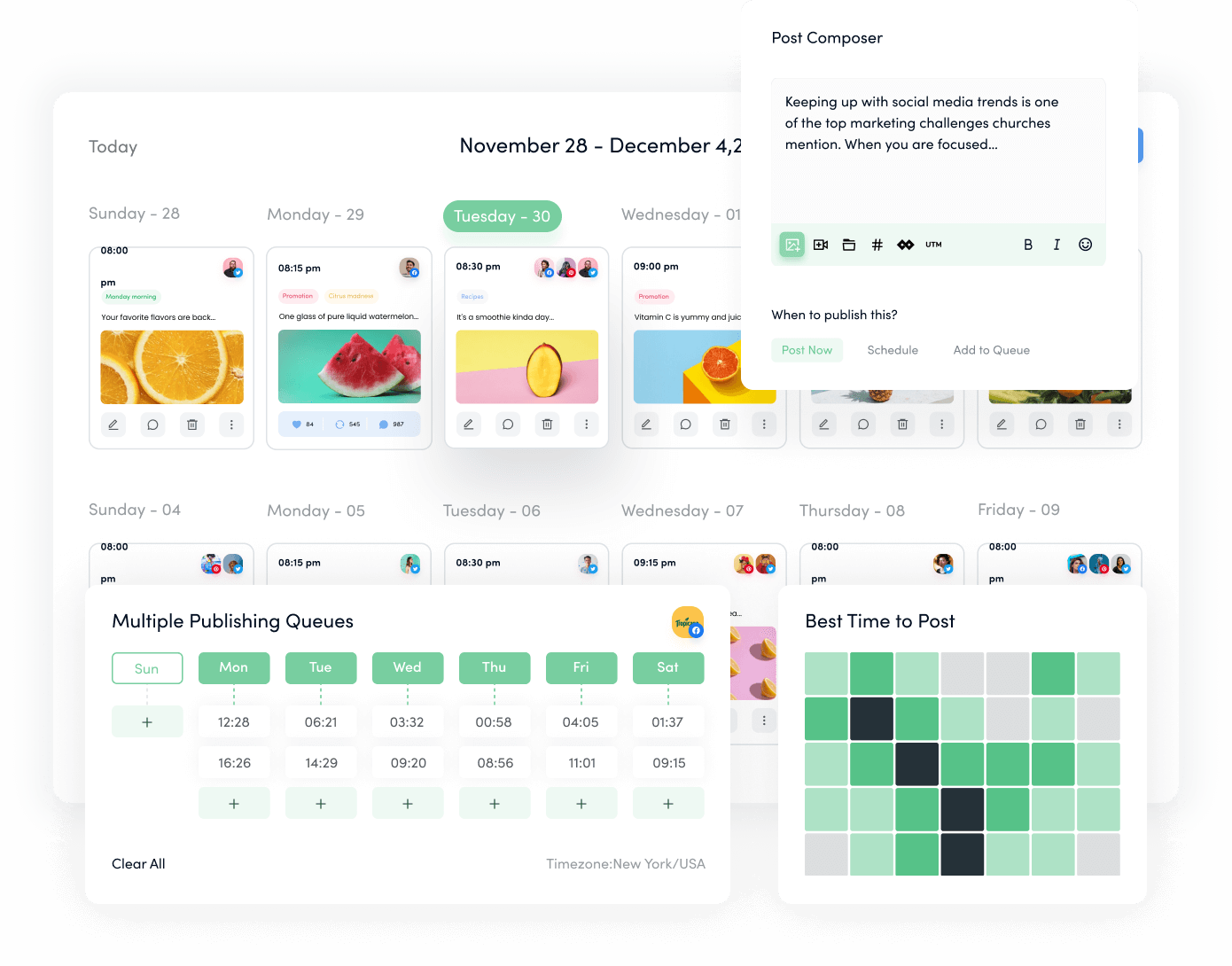
Project management softwares
Project management tools are the key to managing marketing and social media teams. They help companies align the workflow by assigning tasks, delegating responsibilities, tracking deadlines, and keeping track of overall performance.
For example, social media managers use marketing dashboards for social media management. These dashboards provide complete control through a social media approval workflow that keeps a check and balance before publishing.

As a result, it ensures team accountability, minimizes delays, and upholds brand consistency across campaigns.
Analysis and measurement tools
Performance analysis tools are critical for understanding which content delivers results and why some pieces outperform others. Social media measurement and analytics tools track metrics like reach, engagement, click-through rate, and conversions to help marketers adjust their strategies in real-time.
Access to multiple social media analytics tools allows you to measure campaign success, identify top-performing content, and confidently scale what works.
Social Media Analytics
Fine-tune your social media strategy for success with in-depth analytics and white-labeled reports.
Get Started for FREE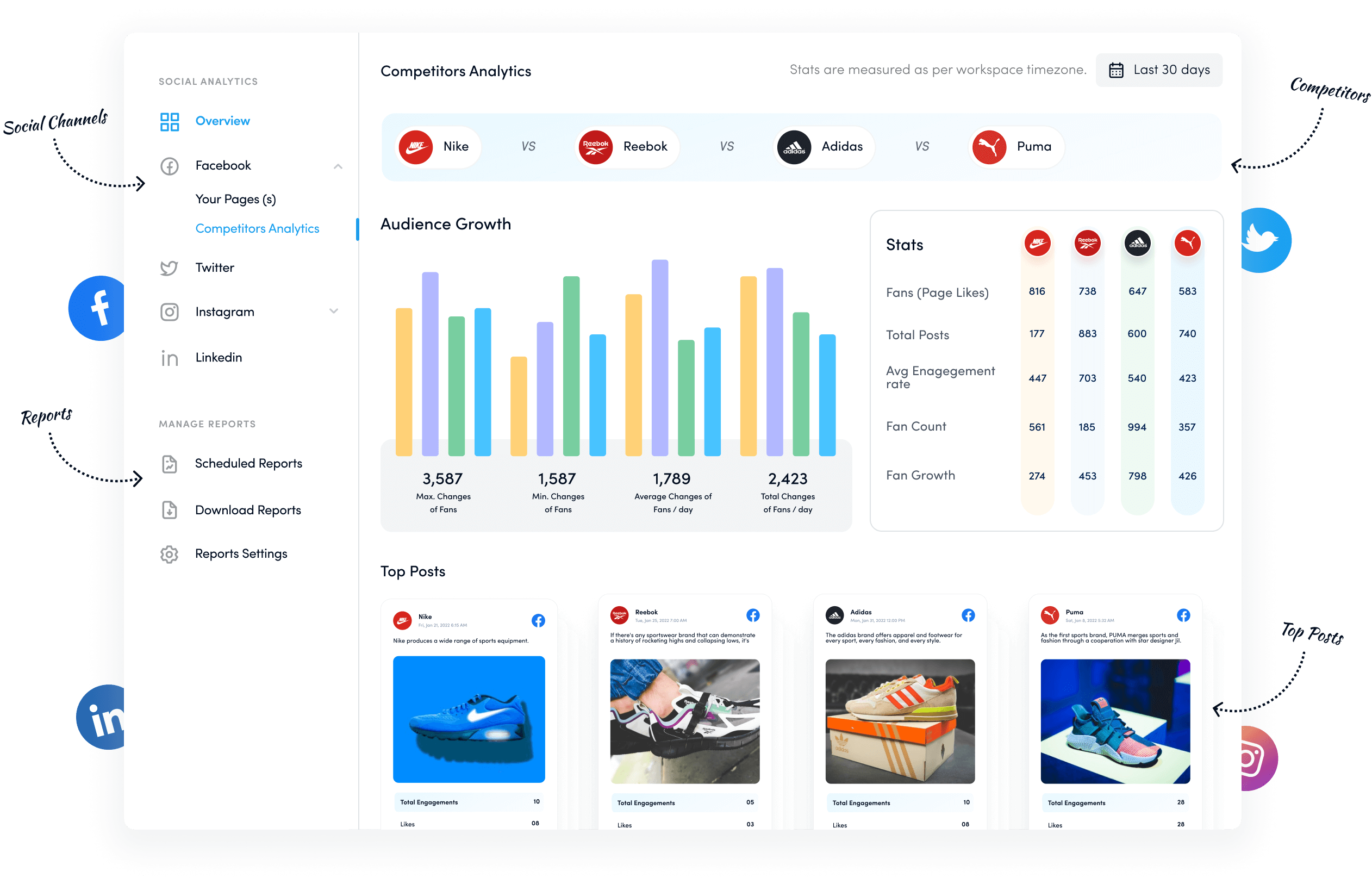
Content scaling case study examples
Let’s take a look at some of the examples of content scaling:
1. Outriggers Hotels outsourced their content creation
ClearVoices shared this case study of how they helped Outriggers Hotels with content creation. They were struggling to find high-quality localized voices for their brand, so ClearVoices paired them with the best-suited writers who matched their requirements and helped them produce effective content.
2. Shelly Palmer increased the blog and overall traffic for an e-commerce client
An e-commerce brand was struggling with content creation and was unable to make an impact with its content. Shelly Palmer’s team utilized the AI content creation to boost the blog output which resulted in a 7% increase in website traffic. It showcases how AI-powered tools can trigger success and growth if they’re used strategically.
3. Narrato Workspace streamlined a content creation agency’s workflow
An agency was facing difficulties with its content creation, management, delivery, and team communication. They had to rely on several third-party tools for different tasks, such as communication, file transferring, plagiarism checking, and word processing. Narrato Workspace provided a complete AI content creation and workflow automation software that transformed how agencies manage their workflows. This case study revealed how Narrato assisted this agency with its ideation, content creation, collaboration, and publishing.
Future trends in content scaling
Here are some of the future trends to keep an eye on:
AI-driven content creation
Advanced AI tools will not just generate content for SEO but also drive brands’ whole content strategy or at least assist in shaping the overall content plan. AI-driven content creation is the future of content marketing, no matter how uncomfortable it looks for many of us.
For instance, Google’s Generative AI technology, which answers the searcher’s query using AI, is surely hurting many SEOs, bloggers, and publishers.
Marketing personalization
Digital marketers will use AI technology to dynamically adjust tone, language, and formats for individual platforms and optimize the content for each audience segment based on demographic data analysis.
So, marketing personalization is one of the areas where AI is going to change the game forever.
Multilingual content automation
Multilingual content is a huge plus in today’s digital marketing landscape, especially if you’re targeting diverse, multicultural masses. Marketing tools will likely support automatic translation and cultural adaptation, allowing brands to scale content globally without hiring full translation teams.
Cross-channel content unification
Future content tools will unify several content marketing areas, such as planning, creation, publishing, and analysis across web, social, email, and even new interfaces like smart devices. AI marketing tools will use predictive analytics to recommend the best time, format, and message tone for each platform.
Data-powered content decisions
One of the implications of AI in content scaling would be in predictive performance analytics. It will help digital marketers and agencies prioritize which types of content to create next and why. Smart, AI-powered marketing tools will keep track of the audience’s behaviors and suggest content ideas that resonate with the audience.
These are some of the future trends in content scaling that are worth noticing.
Conclusion
Content scaling is producing more high-quality content using powerful tactics without spending extra resources. In a nutshell, it’s a systematic content creation approach that skyrockets content generation without breaking the bank.
Brands, influencers, and agencies can adopt content scaling to produce effective, useful content across different platforms. We shared steps to follow, challenges to tackle, and strategies to implement to achieve the maximum outcome from content creation.
Effective content scaling requires the right tools for marketing, automation, content generation, and analytics. Therefore, you’ll find a bunch of tools and resources mentioned in the article.
So, let’s get cracking on it now!
FAQs about content scaling
Let’s answer some of the frequently asked questions about content scaling:
What is content scaling?
Content scaling is a process of creating high-quality content using the systems to ensure a large amount of output without compromising the quality.
What is an example of content creation?
The content creation examples include blog posts, YouTube videos, podcasts, and photos/images – all of these are different types of content that individuals and brands make to market a product or monetize the audience.
What does “content at scale” mean?
Content at scale refers to the strategy of producing a large volume of content (whether it’s articles, videos, podcasts, or graphics) with the highest quality without spending too much time and resources.
Is content creation part of marketing?
Content creation is an integral part of content marketing. Brands, agencies, and influencers use content to attract, engage, and convert the audience. So, yes, content creation is a part of marketing.
Recommended for you
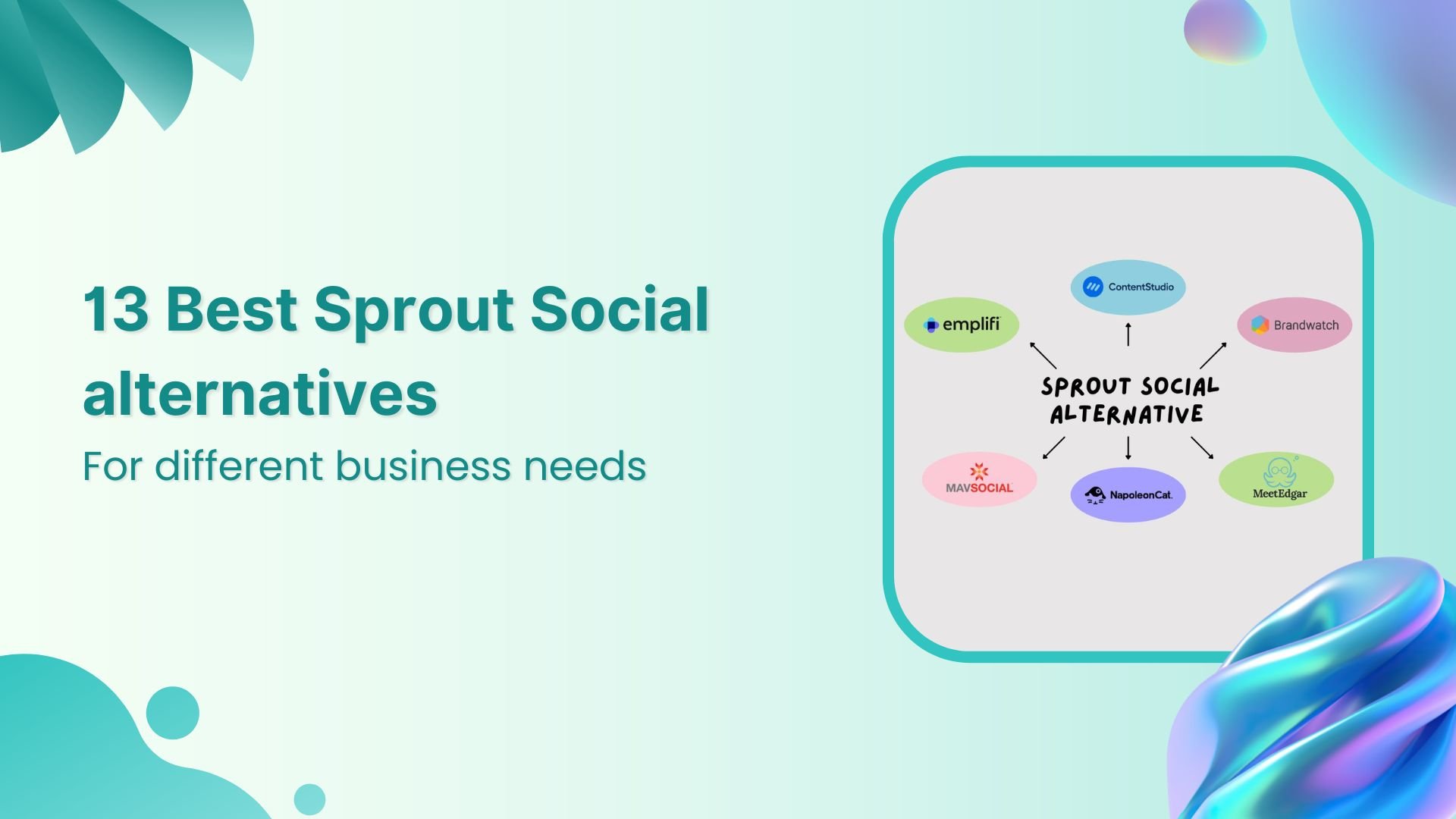
13 Best Sprout Social alternatives for effective social media management

150+ Black Friday quotes, hashtags, and slogans to boost sales

Why is an integrated marketing campaign beneficial for your brand?


Powerful social media management software
14-day free trial - No credit card required.
